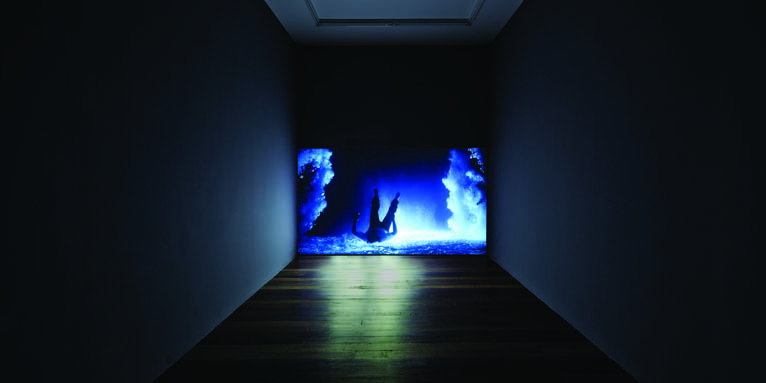CHENG RAN: WHAT WHY HOW
| August 2, 2012 | Post In LEAP 15

The “angel” falls slowly, breaking the water’s shiny surface. Brilliant light, as if from heaven, tears open the infinite stretch of darkness. His body is shrouded in seafoam and bubbles, at once completely submerged in the depths of the water, then hovering in the air, with loud, penetrating cries echoing as if from within the womb. Up until this point, one might assume that Cheng Ran is paying homage to Bill Viola. Suddenly, though, two people in swimsuits, lifeguards, burst in, breaking the meditative atmosphere as they haul him back to reality.
In Western culture, the metaphor of water is often related to redemption. But in this piece the image is inverted and the angel drowns upside down, with his limbs outstretched. Unlike his rescue, he seems to enjoy his free passage through the water granted by a release from gravity, waiting for the rebirth that comes after baptism. Compared to the human experience of religious inspiration and outlook in Viola’s Five Angels for the Millenium, Cheng Ran’s Angels for the Millenium (#6) adds a sense of real-world anxiety, and the appearance of the lifeguards hints at the limitations of individual experience and the unavoidability of interfering powers.
Imprisonment and transgression, extermination and freedom, reality and utopia: binary opposites run throughout the whole exhibition, the gradual farewell to the clamor of youth and the induction into the regulations of the adult world that form this young artist’s direct reflections on his environment. “What Why How” is Cheng Ran’s first solo exhibition, and brings together four video works the artist produced over the past year. The exhibition’s Chinese title borrows from Cheng’s 2010 work of the same name, three English words transliterated, rather than translated, into Chinese. This is a parody of the Chinese translation of Western film titles often seen in Hong Kong, the transformative effect of which displaces the title’s original signification and alludes to the audience’s placement within the postmodern cultural context of the exhibition.
The generation that Cheng Ran represents grew up in a time of pirated DVDs, the Internet, and deluges of second-hand information. Unlike in previous generations, its challenges lay not so much in the need to respond to change, but in the search for self-value within a complex, agglomerate, and multivariate society; distinction is now more important than fusion. This has led their creative works to be especially sensitive to themes of restraint, resistance, and marginalization. Shown in the first-floor screening theater, the video 1971-2000 borrows visual elements and iconic parts of the original soundtrack from two films now regarded as classics of twentieth-century popular culture: Stanley Kubrick’s A Clockwork Orange (1971) and Wim Wenders’ The Million Dollar Hotel (2000).
The protagonists of both films skirt the margins of mainstream discourse, leaving strong impressions in Cheng Ran’s memory. The artist appropriates this flow of emotion as if speaking in intimate murmurs. The bright gallery space on the second floor shows a third video piece, Lostalgia (2012). A play on Andrey Tarkovsky’s 1983 film Nostalgia, the film’s opening scene shows two opposing worlds— the Russian countryside captured in faded black and white, and the fields of rural Italy in thick fog, reminiscent of scenes from pastoral poetry. But Cheng’s edit sidesteps the intellectual’s perspective of melancholy in the original, instead re-playing the scene of a church’s burning, as well as other classical scenarios, using his own methods to probe questions of aesthetics, orthodoxy, and paragon.
As Cheng Ran’s generation of artists gradually enters into popular view, it has begun to throw off the traditions and established frameworks of the Chinese moving image, instead directly drawing inspiration and source material from Western popular culture, be this film, music, or art. Their work rids itself of the ideals of Reformism, taking the image into far more personal realms. Tang Lingjie (Translated by Dominik Salter Dvorak)


